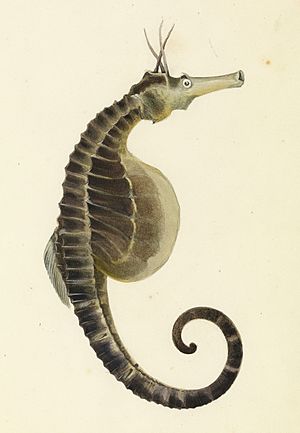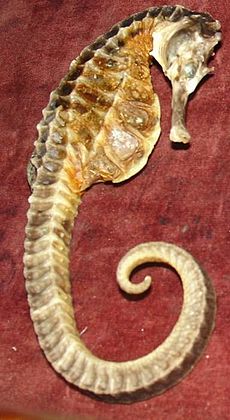Big-belly seahorse facts for kids
Quick facts for kids Big-belly seahorse |
|
|---|---|
 |
|
| Hippocampus abdominalis, from the Sketchbook of fishes by William Buelow Gould, 1832 | |
| Conservation status | |
| Scientific classification | |
| Genus: |
Hippocampus
|
| Species: |
abdominalis
|
| Synonyms | |
|
|
The big-belly seahorse (Hippocampus abdominalis) is also known as the pot-bellied seahorse. It is one of the biggest seahorse types in the world. These amazing creatures can grow up to 35 cm (14 in) long. They are the largest seahorses found in Australia.
Seahorses are a special kind of fish. They belong to the family called Syngnathidae. You can find big-belly seahorses in southeast Australia and New Zealand. They are protected under CITES rules, which helps keep them safe.
Contents
Where Big-Belly Seahorses Live
Big-belly seahorses like to live in different places. You can find them among algae and seagrasses. They also live near rocky reefs in shallow water. In deeper areas, they attach themselves to sponges and other small animals called hydroids.
These seahorses also like to cling to man-made things. This includes jetty piles. They can even be found in estuaries, where rivers meet the sea. They usually live in water less than 50 m (160 ft) deep. But sometimes, they are found as deep as 104 m (340 ft). Young seahorses often float freely in the open ocean or hold onto drifting seaweed.
What Big-Belly Seahorses Look Like
The big-belly seahorse has a unique look. Its head tilts forward and has a long snout. It has a rounded, but narrow, belly that looks like a pot. Its tail is long and can coil up.
They swim upright using their dorsal fin on their back. When they are not swimming, they use their special tail. This tail is prehensile, meaning it can grasp things. They coil it around seaweed or other objects. They wait for tiny planktonic animals to float by. Then, they suck them up with their small mouth, just like a vacuum cleaner!
Seahorses eat a lot. Their main food is small crustaceans like shrimp. They also eat tiny animals like copepods and amphipods that live in seaweed. They don't chew their food. Because their gut is small, they can eat a lot at once. Each of their eyes can move separately. This helps them spot food and watch out for predators at the same time.
It's easy to tell male and female big-belly seahorses apart. Males have a smooth, soft, pouch-like area. This is at the front, where their stomach meets their tail. This is their brood pouch. Females have a more pointed stomach. They also have a very clear fin at the base of their stomach.
How Big-Belly Seahorses Reproduce
In the wild, big-belly seahorses can start having babies when they are about one year old. If they are kept in aquariums, they can start breeding even earlier, around eight months old. They can breed all year long. However, they have more babies during the warmer months.
When it's time to find a mate, the male seahorse changes colors. He also performs special movements. He opens his brood pouch a little. Then, he fills it with water, making it balloon-like. He does this by swimming forward or by pumping his body. After filling it, he closes the pouch opening. He also makes his pouch lighter in color, often white or light yellow. His whole body becomes brighter, usually with more intense yellow colors. The male will swim towards the female he wants to mate with. He tucks his head down. His dorsal and pectoral fins flutter very fast.
If the female is not interested, she will ignore him. The male will then look for another mate. If no females are interested, he stops his display. He deflates his pouch by opening it and bending forward to let the water out.
If a female likes the male, she will show it. She changes her own colors and tucks her head. She usually makes her lighter colors, like yellow and white, brighter. This makes the patterns on her body stand out more. Then, they swim together in short bursts. Sometimes their tails get entwined. The female might also tightly roll up her tail. People often call this their "dancing."
After resting, the male tries to get the female to swim up towards the water surface with him. He does this by pointing his snout upwards many times. If the female also points her snout upwards, the final part of their courtship begins. Both the male and female swim straight up towards the water surface. Their heads point up and their tails point straight down. If they reach the surface, you might see or hear them snap their heads.
To transfer her eggs, the female faces the male. She is usually a little above him. She presses the base of her abdomen against his pouch. Then, she squirts her eggs into the opening of his dilated pouch.
Male seahorses carry the babies. They can brood between 300 and 700 young at one time. They can have up to four groups of babies in the summer. Their color can vary. They are often a shade of brown with yellow-brown mottling and darker spots. Their tail often has yellow bands. In deeper water, where their tail is anchored to colorful things like sponges and hydroids, they can even take on those colors.
Big-Belly Seahorses and People
The big-belly seahorse is a popular choice for home aquariums. Dried seahorses are also sold as traditional medicine in Asia. These seahorses come from the wild or are raised in aquariums. They are quite easy to keep in aquariums. They eat small shrimp and other crustaceans.
Images for kids
See also
 In Spanish: Caballito de mar de vientre grande para niños
In Spanish: Caballito de mar de vientre grande para niños





